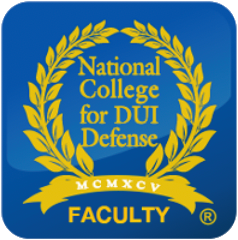Transcript of “The Horizontal Gaze Nystagmus Field Sobriety Test (HGN)”
Author: Steven Oberman
Click here to listen to the podcast.
Originally Posted: June 13, 2011
You’ve seen officers appear to be examining the eyes of drivers on the roadside and on TV shows. Have you wondered what they’re doing? They are likely administering a field sobriety test known as the horizontal gaze nystagmus test.
This is your host, Steve Oberman, and in this episode I will provide a summary of the standardized horizontal gaze nystagmus test (or by it’s initials, the HGN test). As a certified DUI Detection & Standardized Field Sobriety Test instructor, I am aware that it takes days of classroom and laboratory setting training to thoroughly understand the intricacies of this standardized field sobriety test, so keep in mind that this is only an overview.
By the way, this podcast will be much more meaningful if you have first listened to my previous podcast entitled, “The History of Field Sobriety Tests”. So, if you haven’t already listened to that episode, I recommend you do so before continuing.
The first question to be addressed is, what is nystagmus? Nystagmus is an involuntary jerking of the eye. Some researchers believe that if nystagmus is observed during a specifically designed test, it indicates a person’s blood alcohol content is above the legal limit or the person is under the influence of alcohol. Many of our clients believe this is a test to determine if they can follow the stimulus, usually a finger or pen, according to the officer’s instructions. That is a mistaken belief. This test is far more complicated.
Once you learn the basics, you can observe nystagmus by checking your drinking friends at a party. However, I must caution you that while a trained expert may observe nystagmus in those who have consumed alcohol, it does not mean they are either too intoxicated to drive nor does lack of HGN mean they are safe to drive.
Like any field sobriety test, observation of nystagmus is only one factor to determine whether someone is under the influence or has a blood alcohol content above the legal limit. You should never drink and then drive. It is simply not worth the risk of arrest – even if you later demonstrate you are not under the influence.
Now, allow me to briefly describe to you the procedures and scoring of the HGN test. To properly administer this test, the officer must observe three factors or “clues” while observing each eye. They are:
- The subject’s ability to follow a slowly moving object smoothly with the eyes;
- Whether there is moderate or distinct nystagmus in either of the subject’s eyes when moved as far as possible to the side. This portion of the test is referred to as maximum deviation; and
- The angle of onset of nystagmus in each of the subject’s eyes. Specifically, did the nystagmus start before the eye moved forty-five degrees to the side.
Some government researchers found that nystagmus occurring at an angle less than forty-five degrees is an indication the person has a blood alcohol level above the legal limit. The forty-five degree angle is determined separately for each eye, assuming the angle is zero degrees when looking straight ahead, and ninety degrees when looking directly to the side, if that were possible.
Some of our clients complain because they were not wearing their glasses and could not see the stimulus clearly during the test. I explain that nystagmus is not influenced by how clearly the subject can see the object he is to follow. However, subjects with high refractive errors could have trouble seeing the test target without their corrective lens. When administering this test, the officer should advise the subject to keep his head still and follow the object with his eyes, cautioning the subject not to move his eyes back to center until told to do so. The officer should also face the subject away from rotating lights, strobe lights, and traffic in close proximity, as visual and other distractions may compromise the subject’s performance on this test.
During this test, the officer positions the stimulus, often a pen or the officer’s finger, 12-15 inches in front of the subject’s nose and makes sure the subject’s eyes track together. The officer should also examine the subject’s pupils to ensure that they are equal in size. The inability of a subject’s eyes to track together or unequal pupil size are indications of possible injury. These are preliminary tests to determine if the subject is a candidate for the horizontal gaze nystagmus test.
Next, the officer should move the stimulus in a specified manner. For instance, their eyes must be examined in a specified order and the movement of the stimulus must be made in a precise amount of time. At the conclusion of the test, the officer evaluates the subject’s performance by noting how many of the six possible clues were noted. Again, there are three possible clues for each eye. One clue is noted if the onset of the nystagmus occurs prior to forty-five degrees, assuming a portion of the white part of the eye closest to the ear is still visible at the point of nystagmus onset. An additional clue may be noted if distinct and sustained nystagmus is observed when the eye is moved as far laterally as possible. No clue is to be assessed if the officer observes only a faint jerking that occurs at the onset point. A third clue is assessed if the eye cannot follow a moving object smoothly. However, officers are cautioned to move the stimulus smoothly so that this clue will not be noted if the jerkiness was due to the manner in which the object was moved.
A subject who is found to have four or more clues out of the possible six may be classified as having a blood alcohol level above the legal limit, according to the National Highway Traffic Safety Administration research. This original research claimed that the HGN test could accurately indicate that a subject’s blood alcohol level was above .10% approximately 77% of the time. The agency also found it is possible to combine the results of the HGN test and walk-and-turn test and achieve an 80% accuracy (by the way, the walk-and-turn test is explained in another episode).
Subsequent government research in San Diego, CA reported an 88% accuracy level for the HGN test in determining that a subject’s blood alcohol level is above .08%. However, as you may have guessed, I take great issue in the manner in which that study and other studies were conducted and the conclusions that were reached. There are many defenses to an officer’s claim of observing alcohol-induced nystagmus. For instance, since some false positives exist in this test, obviously, some persons may exhibit nystagmus that are not under the influence. Nystagmus may occur naturally in a person, or may be caused by certain pathological disorders such as brain tumors, brain damage and some diseases of the inner ear. Moreover, courts have recognized that HGN may be observed in people who are not under the influence – such as those who have consumed excessive amounts of caffeine; taken aspirin; or suffer from diseases such as Glaucoma; high blood pressure; and even the flu. A lawyer experienced in contesting DUI cases can often demonstrate the HGN test was either given incorrectly or interpreted incorrectly.
So, now you have learned more about the procedures and scoring of the HGN test, which is part of the National Highway Traffic Safety Administration standardized field sobriety test battery. This test is given by an officer so that a better foundation for an opinion of impairment or estimated BLAC may be made before an arrest decision is reached. This is your host, Steve Oberman, inviting you to join us next time to learn more about the issues relating to the crime of Driving Under the Influence of an Intoxicant.
We hope you enjoyed listening to the DUI law podcast1 produced by the Oberman and Rice Law Firm. You may read about related legal matter on our websites at https://tndui.com/ and http://www.duiknoxville.com or visit our blog at http://www.tnduicenter.com. You may also speak to one of our lawyers by calling (865) 249-7200. Until next time, remember to drive safely.
Portions of this podcast were taken from Mr. Oberman’s text, DUI: The Crime and Consequences, Published by West/Thomson Reuters, 2011.See https://tndui.com//oberman-dui-textbooks#tndui
Featured Posts
 March 25, 2025
March 25, 2025
Tennessee Drivers’ Licenses May Go Electronic
Tennessee Senate Bill 1297 was introduced this year proposing to allow Tennesseans to use Digital Driver’s Licenses (DDLs) as a valid form of identification wherever an ID is legally required, except for voting. The DDLs would allow Tennesseans to download an […]
Read More
 February 26, 2025
February 26, 2025
Potential Change in Legislation for Providing Proof of Registration to Law Enforcement
When a driver is pulled over in Tennessee for any reason, the normal request from law enforcement is: “Please provide me with your driver’s license, insurance, and proof of registration.” If you are like this author, digging through your glovebox […]
Read More February 17, 2025
February 17, 2025
Domestic Violence/Domestic Assault/Domestic Abuse Definitions
Domestic Violence/Domestic Assault/Domestic Abuse Definitions We are often asked about the difference between an assault (sometimes referred to as a “simple” assault), and a domestic abuse assault. This is an important distinction in the law because there are different bond […]
Read MoreContact
Office
Oberman & Rice
550 Main Street
Suite 730
Knoxville, TN 37902
Phone Number
(865) 249-7200
(865) 540-1696 (fax)
GPS Coordinates
Long: 35.970504
Lat: -83.914776
Useful Links
contact us today for a free consultation
We reply to non-urgent after-hours requests for consultation within 24 hours. For after-hour emergencies, please call us at (865) 249-7200.














